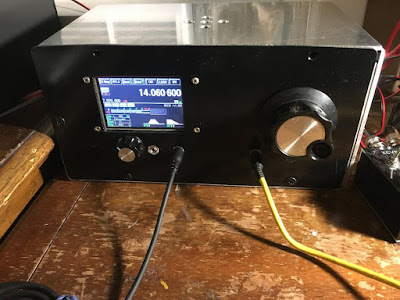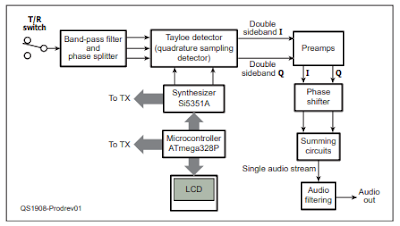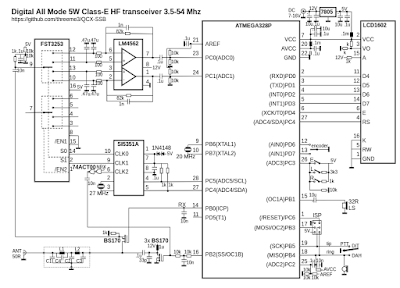Wow, it has been a while since I first talked to Rick, N3FJZ. Above you can see his QSL card. And here is a link to a SolderSmoke blog post (with videos) that describes our Homebrew to Homebrew contact:
The e-mail below shows that Rick continues to melt solder, bringing into his rigs some very cool technology: atomic clocks, GPS modules, and color displays. That's a long way from the original PTO Direct Conversion receiver that he first heard me with. FB Rick!
--------------
Leif,
I've made great progress on my Arduino Mega 2560 based rig controller I call the ZX-Front-Panel. I just finished a feature I always wanted which is a built-in *GPS disciplined frequency counter*. It uses the 1-pulse-per-second timing output from the GPS module to create a frequency counter with atomic-clock accuracy. It's on the solderless breadboard with the rest of the ZX-Front-Panel right now, and even so, it can count up to 30MHz with no trouble! and it should be able to count up to 100MHz or more if built on a ground plane with a little shielding. The best part about it is that it only required one additional chip (a 74LV8154 32-bit counter $1 from Mouser) in addition to the existing parts already on the ZX-Front-Panel; i.e. the Arduino Mega 2560 ($10), the Ublox NEO-6N GPS module ($15), the display ($25), and the Si5351 PLL RF Oscillator ($8).
Check out my video series covering the ZX-Front-Panel development progress. The first link below will bring up the video page on my website with the latest video at the top, so you'll have to scroll down a bit to get to the earlier development stages. Check out the rest of the website too for the schematics of my Bitx / TIA inspired rig design (which I call the ZX-SSB-II) that I used an early version of to make my first HF HB2HB contact with Bill (N2CQR) back in 2014 or so (Bill and Pete, via the Soldersmoke podcast, were my inspiration to build my first SSB homebrew rig).
YouTube videos: http://www.remmepark.com/circuit6040/ZX-SSB-II-Front-Panel/ZX-SSB-II-Front-Panel.html#video
Homepage: http://www.remmepark.com/circuit6040/index.html
Dean AC9JQ and I have been communicating via emailing about his progress in building his own copy of the ZX-Front-Panel, and I'm very excited to learn that he might be thinking about producing a future homebrew rig featuring the ZX-Front-Panel as its controller/VFO. The best thing about the ZX_Front-Panel is that ounce you install the sketch into the Arduino Mega, you don't need to modify the Arduino sketch itself when you build your rig; i.e. the SSB crystal filter's center frequency (the I.F. frequency), the Si5351's clock output drive level, the display brightness and contrast, and the Si5351 crystal correction factor (crystal trim) are all configurable, real-time, right from the ZX-Front-Panel's user interface, and once set, can be saved to the Arduino's non-volatile EEPROM to be automatically loaded on the next power-up. Also, since it has a GPS module, it features a UTC/Local real-time clock with atomic clock accuracy too.
Anyway that's all for now, take care Leif.
73 Rick.
I've made great progress on my Arduino Mega 2560 based rig controller I call the ZX-Front-Panel. I just finished a feature I always wanted which is a built-in *GPS disciplined frequency counter*. It uses the 1-pulse-per-second timing output from the GPS module to create a frequency counter with atomic-clock accuracy. It's on the solderless breadboard with the rest of the ZX-Front-Panel right now, and even so, it can count up to 30MHz with no trouble! and it should be able to count up to 100MHz or more if built on a ground plane with a little shielding. The best part about it is that it only required one additional chip (a 74LV8154 32-bit counter $1 from Mouser) in addition to the existing parts already on the ZX-Front-Panel; i.e. the Arduino Mega 2560 ($10), the Ublox NEO-6N GPS module ($15), the display ($25), and the Si5351 PLL RF Oscillator ($8).
Check out my video series covering the ZX-Front-Panel development progress. The first link below will bring up the video page on my website with the latest video at the top, so you'll have to scroll down a bit to get to the earlier development stages. Check out the rest of the website too for the schematics of my Bitx / TIA inspired rig design (which I call the ZX-SSB-II) that I used an early version of to make my first HF HB2HB contact with Bill (N2CQR) back in 2014 or so (Bill and Pete, via the Soldersmoke podcast, were my inspiration to build my first SSB homebrew rig).
YouTube videos: http://www.remmepark.com/circuit6040/ZX-SSB-II-Front-Panel/ZX-SSB-II-Front-Panel.html#video
Homepage: http://www.remmepark.com/circuit6040/index.html
Dean AC9JQ and I have been communicating via emailing about his progress in building his own copy of the ZX-Front-Panel, and I'm very excited to learn that he might be thinking about producing a future homebrew rig featuring the ZX-Front-Panel as its controller/VFO. The best thing about the ZX_Front-Panel is that ounce you install the sketch into the Arduino Mega, you don't need to modify the Arduino sketch itself when you build your rig; i.e. the SSB crystal filter's center frequency (the I.F. frequency), the Si5351's clock output drive level, the display brightness and contrast, and the Si5351 crystal correction factor (crystal trim) are all configurable, real-time, right from the ZX-Front-Panel's user interface, and once set, can be saved to the Arduino's non-volatile EEPROM to be automatically loaded on the next power-up. Also, since it has a GPS module, it features a UTC/Local real-time clock with atomic clock accuracy too.
Anyway that's all for now, take care Leif.
73 Rick.





































